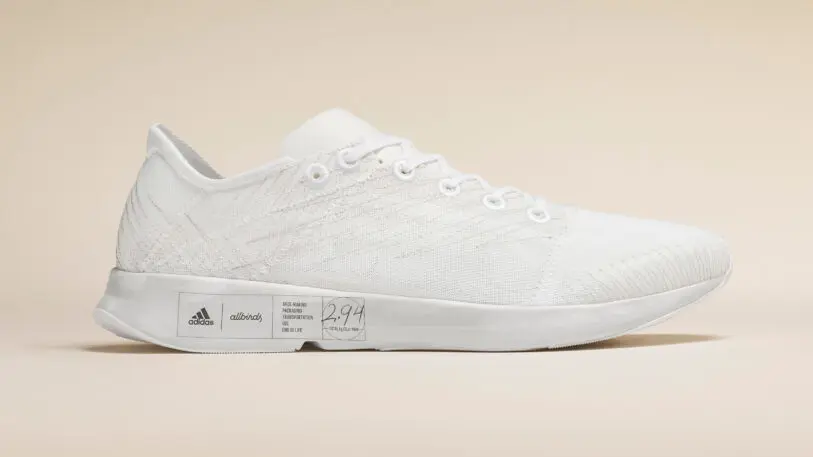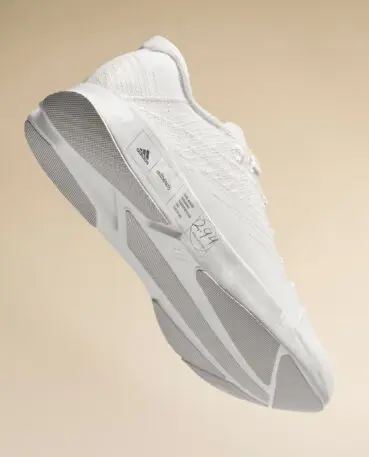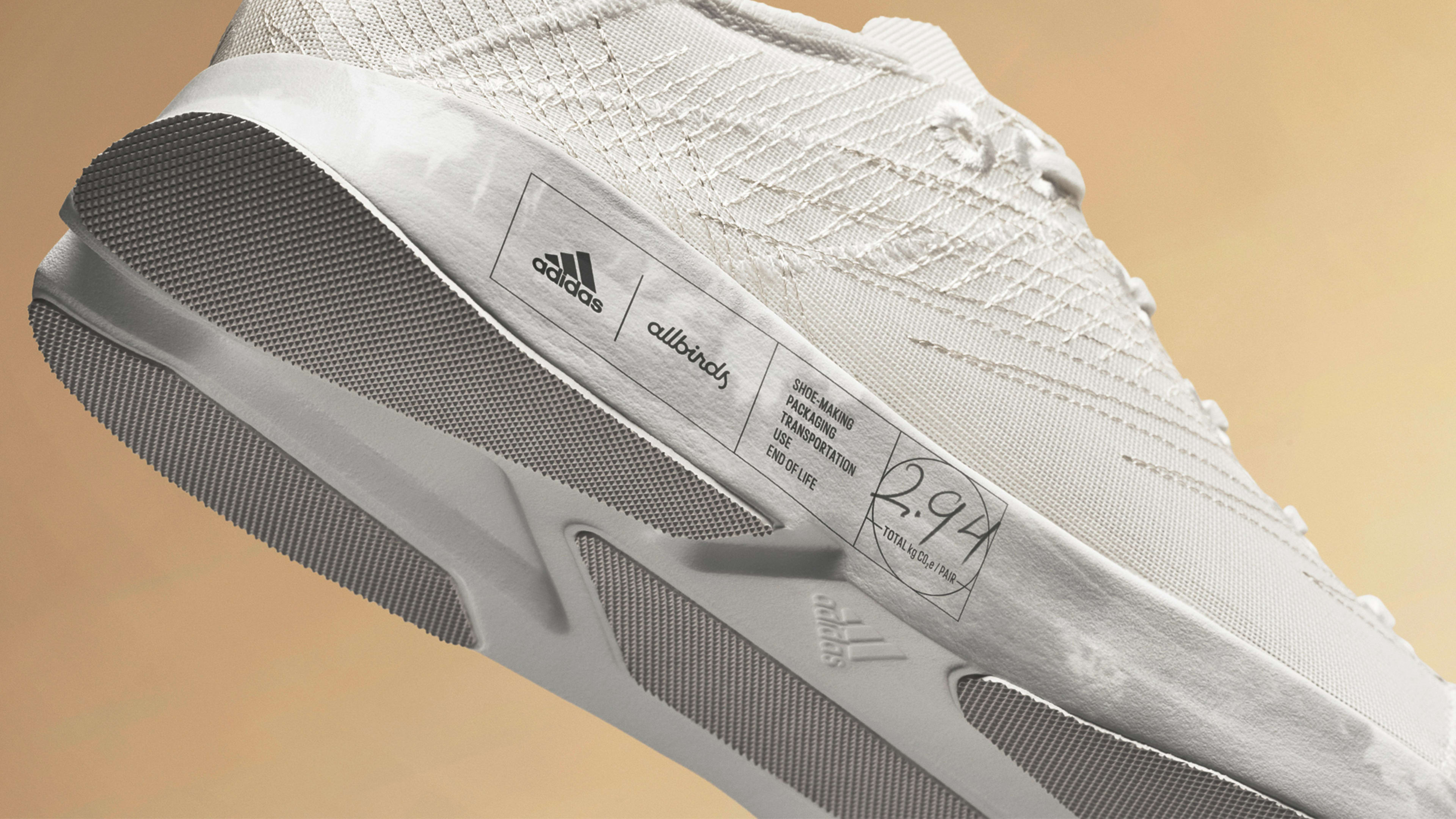In 2020, in the midst of the pandemic, the global sneaker house Adidas and the sustainable, direct-to-consumer shoe brand Allbirds announced they were teaming up to make the most sustainable sneaker ever. Today, we get a look at that shoe for the first time.
It’s called the Futurecraft.Footprint. And while an MIT study from 2013 found the average sneaker had a 30-pound CO2 footprint—about the same as eating about 3.5 Big Macs—the Futurecraft.Footprint comes in at under 3 kilograms of CO2 per pair. It’s 2.94 kilograms to be exact—a number hand written on every shoe.

Originally, the team had set a public goal of building a pair of shoes with a 2-kilogram CO2 footprint within a year. They fell a bit short of that, but the design still has just a fifth the carbon footprint of a standard sneaker, and about half the footprint of the best shoes both Adidas and Allbirds have made to date. The impressive figure was only possible by the two companies sharing their technologies, while questioning every best practice of sneaker design.
“When you’re after a number so low, and ultimately zero-carbon footprint . . . every little sliver matters. There’s no initiative too small,” says Kajimura. “We were making product decisions—not just should we use this material or not—but should we weave it or knit it, dye it or not dye it.”
Building Frankenstein’s shoe
After first meeting two years ago, the teams began development in early 2020 with an audit of the entire shoe supply chain, from sourcing materials, to production, to shipping the product itself.
“The constant challenge is there are so many factors on the shoemaking level that impact carbon footprint,” says Kimia Yaraghchian, product manager at Adidas Running. “The yarn, material, and the structure of material. The construction of the product itself, and the amount of pieces it has.”
Let’s begin with the shoe’s materials, which are a literal fusion of Adidas and Allbirds technology. The upper—the fabric top of the shoe—is made from 70% Adidas’s recycled Primegreen polyester and 30% natural Tencel, a material made from wood pulp that Allbirds uses in its Tree line. The midsole—the bouncy foam at the bottom of the shoe—is a combination of Adidas’s Lightstrike polyurethane foam and Allbirds’ sugarcane-based SweetFoam.
The materials are undyed, which further saves on emissions. And yet, “it’s not just a burlap-strap brown,” as Jad Finck, head of sustainability at Allbirds, puts it. No, the shoes appear to be a true white that looks completely typical for a modern sneaker. That’s because, while materials like the upper are produced from trees, the purification process to make this textile also removes natural color. Ironically, natural materials can look quite industrial!
Look closer at that upper, and you’ll see how strangely it’s made. Instead of being one sheet of fabric with a few cutouts here or there, it’s Frankenstein’s monster, with all sorts of small parts stitched together with more and more seams.
This approach is counterintuitive because it’s so complicated. Generally, simpler design is considered better. Fewer parts equals more elegance both aesthetically and philosophically. As the legendary industrial designer Dieter Rams put it, “good design is as little design as possible.”
But this patchwork-quilt approach makes a big difference when producing the shoe with little waste. Generally, fabric is rolled out as a square and stamped out like a cookie. This leaves bits of fabric that go unused and contribute to a product’s waste.
Nike has dealt with these factory scraps in the past with its Space Hippie line, which reincorporates the material left over from one shoe into another shoe’s design. Adidas and Allbirds took a different approach. By building the upper from more, strange puzzle pieces, they were able to utilize each nook and cranny of the fabric when cutting it into a shoe for the first time. (Each shoe has an identical, optimized pattern, scaled to the shoe size; the geometry isn’t bespoke shoe to shoe).
“It’s much easier to fit in a bunch of smaller shapes to save waste than having one big band,” says Finck.
Losing weight
But did they need to be stitched together so overtly on the outside of the shoe? Or is that choice the design equivalent of virtue signaling? See how many pieces of fabric my upper is made of! It’s green as heck!
No, in fact, the stitches are influenced by the third major design goal of this shoe: for it to be as light as possible. “Weight is one of the overlooked levers of carbon footprint . . . probably the most powerful lever of reducing the carbon footprint of everything,” says Kajimura. That’s because weight affects everything from bringing materials to a factory, to managing them in production, to shipping a product, to laundering a product (if it has more material that needs to be cleaned), to ultimately disposing of a product. The heavier it is, the more its weight causes a ripple across its CO2 footprint.

The team continued with its material cuts into the outsole, the rubbery bottom of the shoe. Made of denser, more durable material than the bouncy midsole, the outsole can be responsible for a lot of the weight of the shoe, so it required a fresh approach to minimize its impact.
“The outsole is not a full outsole,” explains Yaraghchian. “It’s several pieces on the outsole to save material and weight. [It’s] carving out, taking away, being more extreme with less product, but still achieving the same performance.” The outsole shapes, like those of the upper, were designed to be stamped from patterns efficiently.
While each of these decisions is relatively small, what it all adds up to is Futurecraft.Footprint, a shoe that appears to have the lowest carbon footprint of any performance sneaker on the market. It will go on sale in a super-limited batch of 100 to collectors this May before a wider release of 10,000 units in December (and a wide release next year). But for now, the Futurecraft.Footprint is a symbol for how the entire design world has had to shift its priorities in the face of climate change.
“You’re always checking performance, always checking cost,” says Finck. “Now there’s this third one: the carbon. We have this extra column we’re checking against; it’s a very different design challenge.”
Recognize your brand’s excellence by applying to this year’s Brands That Matter Awards before the early-rate deadline, May 3.
